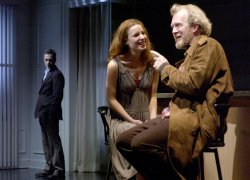
"Room" for Improvement
by
Dorothy Chansky
 |
| Josh Charles, Kate Arrington and ensemble member Tracy Letts in "The Well-Appointed Room," by Richard Greenberg, directed by Steppenwolf co-founder Terry Kinney. |
Review of "TheWell-Appointed Room"
Steppenwolf Theatre
1650 North Halsted Sreet
Chicago, Illinois 60614
Closed March 12
Box Office: (312)335-1650 or www.steppenwolf.org
Midway through the second of the two linked one-acts that make up Richard Greenberg's new play, "The Well-Appointed Room," Tracy Letts unprepossessingly but surehandedly stole the evening from everyone else onstage, including himself in his first-act role. The character Letts conjured is named Mitchell, but to the husband and wife whose lives he affects, he is respectively Lucifer destroying a marriage or a kindred spirit on a rainy night. Letts turned a beyond-ordinary low-level editorial researcher on a suburban paper into a simpatico sadsack symbolic of everything that's wrong with a culture that prizes style over sincerity and values the way the media tells us life ought to be over the way our guts and eyes tell us it is. Bedraggled, mumbly, and hunch-shouldered, Letts was spellbinding.
The room of Greenberg's title is the open-layout living/dining/kitchen area of a Manhattan apartment pre- and post-9/11. In the first play, "Nostalgia," a self-satisfied, late-middle-aged playwright, Stewart (Letts), and his hyper-literate wife, Natalie (Amy Morton), trade insults while he tries to prepare brunch.
Natalie derides Stewart for thinking Wantagh is his "Dublin or Yoknopatawpha County" and he asks her if she is Mrs. Strindberg or merely simple gastritis, as the notoriously misogynistic Swede thought his wife lived in his stomach. Stewart burns the omelette but chucks it out and starts another, opting for angst and waste (Greenberg gives him a dutiful Cliff Notes version of soul-searching) over virtue and brown edges (with obligatory culinary pretentiousness). Natalie derides Stewart's work (including multiple examples of his borderline plagiarism) and his sense of self to the point that I began to wonder why she stuck around at all. That, apparently, was the point, as the suitcase she parked front and center at the start of this production was the loaded gun that went off at the end, and none too soon.
The same apartment (renovated, of course) figures in the evening's second piece, "Prolepsis." Narrated by a young businessman, Mark, whose greatest joy was once his wife, the piece is a kind of fable for the disaffected.
Mark (a winning but ordinary Josh Charles) keeps returning to the observation that a "more astute man might have" seen what was happening, taken care of things better, or spotted a problem in the marriage he warns us will yield a story we will find "upsetting." His wife Gretchen is, it seems, either clairvoyant or bonkers. (Kate Arrington played the role as an appealing blend of free spirit and hausfrau). Whether Gretchen is a prophet or delusional, Mark is in denial. The off-beat, open, loving girl he met at the bus stop begins (after they move into "the" apartment and she finds she is pregnant) to imagine their youth, the life of the baby she is carrying, and even their middle and old age in the past tense. She resides, as she acceptingly tells her bewildered husband, in the realm of nostalgia. Ah. Even a visit to the apartment by a wisdom-dispensing old woman handily found in the same bar where Gretchen met Mitchell fails as a wake-up call.
Greenberg's territory is the hothouse realm of "New Yorker" worries, obsessions, and privilege. Unlike the best of the magazine's cartoons, though, Greenberg's characters here seem underscored and obvious. "Nostalgia" was not helped by the fact that Letts and Morton were utterly unconvincing as Jews, and Jewishness (or at least the Manhattan variety) is at the heart of these characters' identities. Letts is too blonde, too open, and simply too west of the Mississippi, while Morton showed herself and her character to better advantage in "Prolepsis" as the porcelain-skinned WASP failed writer who was able to take to her bed for fifty years thanks to a bit of family money.
The real star of this production was scenic designer Robert Brill's set. The hyper-real apartment of the first one-act was so, well, "well-appointed" that it appeared immovable. Wrong. "Prolepsis" started minus so much as a wall, much less the well-stocked built-in bookshelves, recessed lighting, and working kitchen appliances that defined the mid-century (and presumably behind the beat) world of the soon-to-be-replaced tenants. Gradually, via projections and pieces that seem to materialize out of nowhere, the apartment returned, renovated and with its own special light coming from the window whose view was one of its selling points. The kitchen bar stools became the bar where the two young people fatefully meet the two allegorical messengers. Brill's floor plan and Terry Kinney's smart staging allowed past and present, dream and reality to merge, cleverly refusing to take sides as to which is which.
Unfortunately, audiences do take sides. Stewart, the playwright of "Nostalgia," deflects his wife's criticism by pointing to his commercial success, smugly reminding her that "the audience exists." "Yes," she counters, "but is it awake?" As I started up the aisle at the end of the show, a well-dressed man of a certain age dryly delivered his review to his companion: "the set was great." The audience is awake.

| museums | NYTW mail | recordings | coupons | publications | classified |